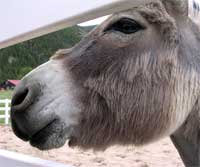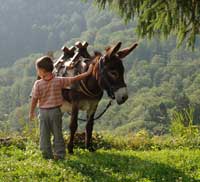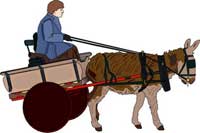|

 Stubborn?: Donkeys have a reputation for stubbornness, but this is due to some handlers' misinterpretation of their highly-developed sense of self preservation. It is difficult to force or frighten a donkey into doing something it sees as contrary to its own best interest, as opposed to horses who are much more willing to, for example, go along a path with unsafe footing. Stubborn?: Donkeys have a reputation for stubbornness, but this is due to some handlers' misinterpretation of their highly-developed sense of self preservation. It is difficult to force or frighten a donkey into doing something it sees as contrary to its own best interest, as opposed to horses who are much more willing to, for example, go along a path with unsafe footing.
Brains: Although formal studies of their behavior and cognition are rather limited, donkeys appear to be quite intelligent, cautious, friendly, playful, and eager to learn. They are many times fielded with horses due to a perceived calming effect on nervous horses. If a donkey is introduced to a mare and foal, the foal will often turn to the donkey for support after it has left its mother.
 Pets: Once a person has earned their confidence they can be willing and companionable partners and very dependable in work and recreation. For this reason, they are now commonly kept as pets in countries where their use as beasts of burden has disappeared. They are also popular for giving rides to children in holiday resorts or other leisure contexts. They are even used in donkey shows. Pets: Once a person has earned their confidence they can be willing and companionable partners and very dependable in work and recreation. For this reason, they are now commonly kept as pets in countries where their use as beasts of burden has disappeared. They are also popular for giving rides to children in holiday resorts or other leisure contexts. They are even used in donkey shows.
In prosperous countries, the welfare of donkeys both at home and abroad has recently become a concern, and a number of sanctuaries for retired donkeys have been set up.

The Poitou donkey breed was developed in France for the sole purpose of producing mules. It is a large donkey breed with a very long shaggy coat and no dorsal stripe.
Possible Advertisement
Spanish burros: The Spanish brought burros to North America beginning in the late fifteenth century. These burros were used as pack animals, but also for riding and pulling carts.
 Pack animals: These pack animals were prized for their hardiness in arid country and became the beast of burden of choice by early prospectors in the Southwest United States. The wild burros on the western rangelands descend from burros that escaped, were abandoned, or were freed. Pack animals: These pack animals were prized for their hardiness in arid country and became the beast of burden of choice by early prospectors in the Southwest United States. The wild burros on the western rangelands descend from burros that escaped, were abandoned, or were freed.
Wild burros in the United States are protected by Public Law 92-195, The Wild Free-Roaming Horses and Burros Act of 1971. These animals, considered to be a living legacy, have lately been at risk due to drought. The Bureau of Land Management conducts round-ups of endangered herds, and holds public auctions. More information can be obtained from U.S. Department of the Interior, Bureau of Land Management.
Wild burros make good pets when treated well and cared for properly. They are clever and curious. When trust has been established, they appreciate, and even seek, attention and grooming.
With domestication of almost all donkeys, few species now exist in the wild. Some of them are the African Wild Ass (Equus africanus) and its subspecies Somalian Wild Ass (Equus africanus somaliensis). The Onager, Equus hemionus, and its relative the Kiang, Equus kiang, are closely related wild species.
There was another extinct subspecies called the Yukon Wild Ass (Equus asinus lambei). In the wild the asses can reach top speeds equaling zebras and even most horses.
All text is available under the terms
of the GNU Free Documentation License
|